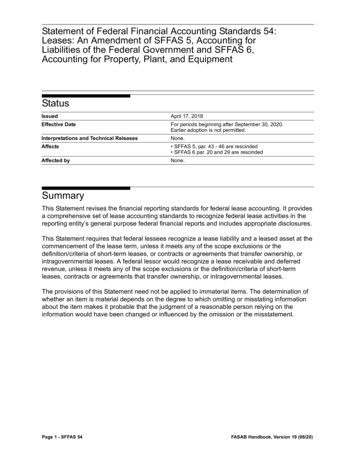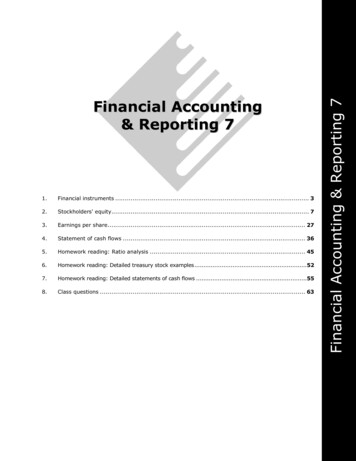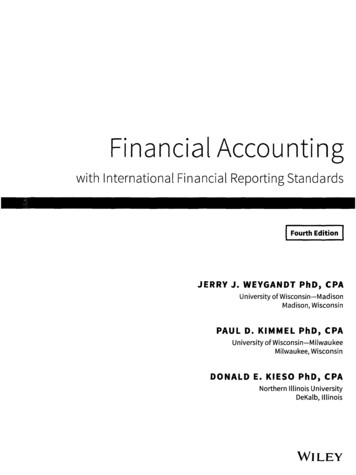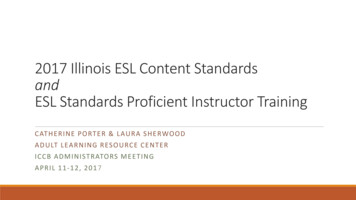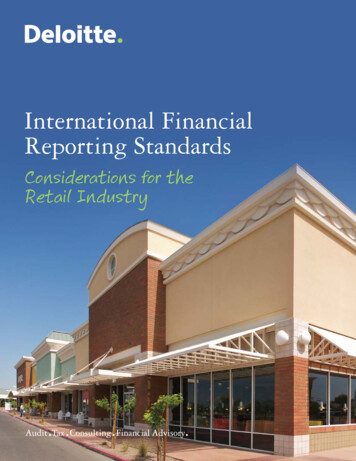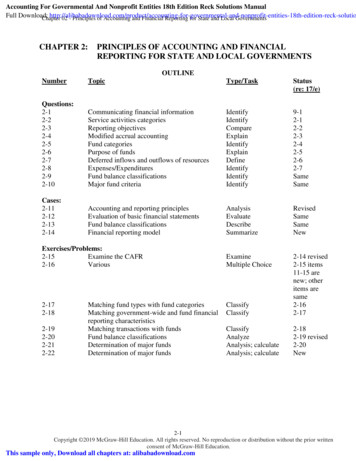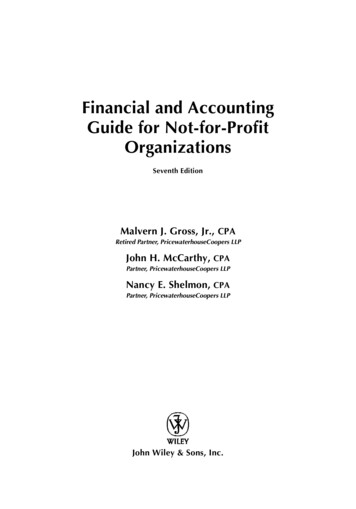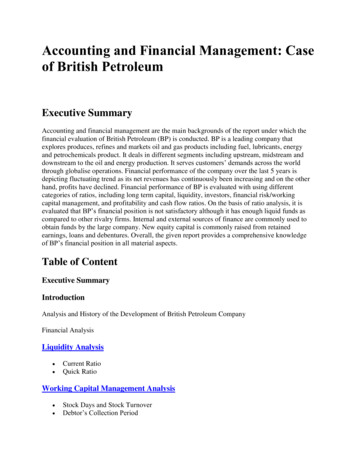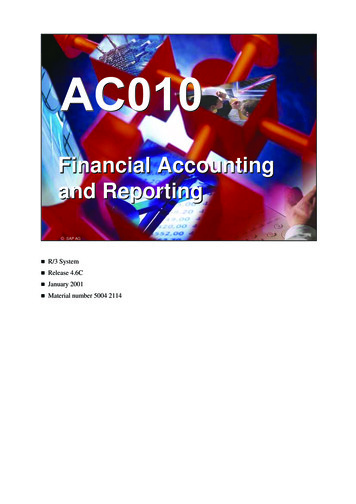
Transcription
1-1
Chapter 1Accounting in ActionLearning ObjectivesAfter studying this chapter, you should be able to:1-21.Explain what accounting is.2.Identify the users and uses of accounting.3.Understand why ethics is a fundamental business concept.4.Explain accounting standards and the measurement principles.5.Explain the monetary unit assumption and the economic entityassumption.6.State the accounting equation, and define its components.7.Analyze the effects of business transactions on the accounting equation.8.Understand the four financial statements and how they are prepared.
Preview of Chapter 1Financial AccountingIFRS Second EditionWeygandt Kimmel Kieso1-3
What is Accounting?Accounting consists of three basic activities - it identifies, records, and communicatesthe economic events of an organization to interested users.1-4LO 1 Explain what accounting is.
What is Accounting?Three ActivitiesIllustration 1-1The activities of theaccounting processThe accounting process includesthe bookkeeping function.1-5LO 1 Explain what accounting is.
Who Uses Accounting editorsMarketing1-6RegulatoryAgenciesInvestorsLO 2 Identify the users and uses of accounting.
Who Uses Accounting DataCommon Questions AskedUser1. Can we afford to give ouremployees a pay raise?Human Resources2. Did the company earn asatisfactory income?Investors3. Should any product lines beeliminated?Management4. Is cash sufficient to pay dividendsto shareholders?Finance5. What price for our product willmaximize net income?Marketing6. Will the company be able to payits debts?Creditors1-7LO 2 Identify the users and uses of accounting.
The Building Blocks of AccountingEthics In Financial ReportingStandards of conduct by which one’s actions are judged asright or wrong, honest or dishonest, fair or not fair, areethics.1-8 Recent financial scandals include: Enron (USA),Parmalat (ITA), Satyam Computer Services (IND), AIG(USA), and others. Effective financial reporting depends on sound ethicalbehavior.LO 3 Understand why ethics is a fundamental business concept.
The Building Blocks of AccountingEthics In Financial ReportingIllustration 1-4Steps in analyzing ethics casesand situations1-9LO 3 Understand why ethics is a fundamental business concept.
1-10
The Building Blocks of AccountingAccounting StandardsInternational Accounting Standards Board (IASB)http://www.iasb.org/International Financial Reporting Standards (IFRS)Financial Accounting Standards Board (FASB)http://www.fasb.org/Generally Accepted Accounting Principles (GAAP)1-11LO 4 Explain accounting standards and the measurement principles.
The Building Blocks of AccountingMeasurement PrinciplesCost Principle – or historical cost principle, dictates thatcompanies record assets at their cost.Fair Value Principle – states that assets and liabilitiesshould be reported at fair value (the price received to sell anasset or settle a liability).1-12LO 4 Explain accounting standards and the measurement principles.
1-13
The Building Blocks of AccountingAssumptionsMonetary Unit – include in the accounting records onlytransaction data that can be expressed in money terms.Economic Entity – requires that activities of the entity bekept separate and distinct from the activities of its owner andall other economic entities.1-14 Proprietorship. Partnership. Corporation.Forms of BusinessOwnershipLO 5 Explain the monetary unit assumptionand the economic entity assumption.
Forms of Business OwnershipProprietorship Generally ownedby one person Owned by two ormore persons Often smallservice-typebusinesses Often retail andservice-typebusinessesOwner receivesany profits,suffers anylosses, and ispersonally liablefor all debts 1-15Partnership Generallyunlimitedpersonal liabilityCorporation Ownershipdivided intoshares Separate legalentity organizedunder corporationlaw Limited liabilityPartnershipagreementLO 5 Explain the monetary unit assumptionand the economic entity assumption.
Indicate whether each of the following statements presented belowis true or false.1.The three steps in the accounting process areidentification, recording, and communication.2.The two most common types of external users areFalseinvestors and company officers.3.Shareholders in a corporation enjoy limited legalliability as compared to partners in a partnership.1-16TrueTrueLO 5 Explain the monetary unit assumptionand the economic entity assumption.
Indicate whether each of the following statements presented belowis true or false.4.The primary accounting standard-setting body outsidethe United States is the International AccountingTrueStandards Board (IASB).5.The cost principle dictates that companies recordassets at their cost. In later periods, however, the fairFalsevalue of the asset must be used if fair value is higherthan its cost.1-17LO 5 Explain the monetary unit assumptionand the economic entity assumption.
1-18
The Basic Accounting EquationAssets Liabilities EquityProvides the underlying framework for recording andsummarizing economic events.Applies to all economic entities regardless of size.1-19LO 6 State the accounting equation, and define its components.
The Basic Accounting EquationAssets Liabilities EquityProvides the underlying framework for recording andsummarizing economic events.Assets1-20 Resources a business owns. Provide future services or benefits. Cash, Inventory, Equipment, etc.LO 6 State the accounting equation, and define its components.
The Basic Accounting EquationAssets Liabilities EquityProvides the underlying framework for recording andsummarizing economic events.Liabilities1-21 Claims against assets (debts and obligations). Creditors - party to whom money is owed. Accounts payable, Notes payable, etc.LO 6 State the accounting equation, and define its components.
The Basic Accounting EquationAssets Liabilities EquityProvides the underlying framework for recording andsummarizing economic events.Equity1-22 Ownership claim on total assets. Referred to as residual equity. Share capital-ordinary and retained earnings.LO 6 State the accounting equation, and define its components.
The Basic Accounting EquationIllustration 1-7Revenues result from business activities entered into for the purposeof earning income.Generally results from selling merchandise, performing services,renting property, and lending money.1-23LO 6 State the accounting equation, and define its components.
The Basic Accounting EquationIllustration 1-7Expenses are the cost of assets consumed or services used in theprocess of earning revenue.Common expenses are salaries expense, rent expense, interestexpense, property tax expense, etc.1-24LO 6 State the accounting equation, and define its components.
The Basic Accounting EquationIllustration 1-7Dividends are the distribution of cash or other assets to shareholders.1-25 Reduce retained earnings Not an expenseLO 6 State the accounting equation, and define its components.
Classify the following items as issuance of shares, dividends,revenues, or expenses. Then indicate whether each itemincreases or decreases equity.ClassificationEffect on Equity1. Rent expenseExpenseDecrease2. Service e3. Dividends4. Salaries expense1-26LO 6 State the accounting equation, and define its components.
Using the Accounting EquationTransactions are a business’s economic events recordedby accountants.1-27 May be external or internal. Not all activities represent transactions. Each transaction has a dual effect on the accountingequation.LO 7 Analyze the effects of business transactions on the accounting equation.
Using the Accounting EquationIllustration: Are the following events recorded in the iscussproductdesign withcustomer.Illustration 1-8Pay rent.Is the financial position (assets, liabilities, or equity)of the company changed?Record/Don’t Record1-28LO 7 Analyze the effects of business transactions on the accounting equation.
Using the Accounting EquationTransaction AnalysisIllustration 1-9Expanded accounting equation1-29LO 7 Analyze the effects of business transactions on the accounting equation.
Transaction AnalysisTransaction (1). Investment by Shareholders. Ray and Barbara Nealdecides to open a computer programming service which he namesSoftbyte. On September 1, 2014, they invest 15,000 cash in exchange for 15,000 of ordinary shares.Illustration 1-101-30LO 7
Transaction AnalysisTransaction (2). Purchase of Equipment for Cash. Softbyte purchasescomputer equipment for 7,000 cash.Illustration 1-101-31LO 7
Transaction AnalysisTransaction (3). Purchase of Supplies on Credit. Softbyte purchasesfor 1,600 from Acme Supply Company computer paper and other suppliesexpected to last several months. The purchase is on account.Illustration 1-101-32LO 7
Transaction AnalysisTransaction (4). Services Provided for Cash. Softbyte receives 1,200cash from customers for programming services it has provided.Illustration 1-101-33LO 7
Transaction AnalysisTransaction (5). Purchase of Advertising on Credit. Softbyte receives abill for 250 from the Daily News for advertising but postpones paymentuntil a later date.Illustration 1-101-34LO 7
Transaction AnalysisTransaction (6). Services Provided for Cash and Credit. Softbyteprovides 3,500 of programming services for customers. The companyreceives cash of 1,500 from customers, and it bills the balance of 2,000on account.Illustration 1-101-35LO 7
Transaction AnalysisTransaction (7). Payment of Expenses. Softbyte pays the followingexpenses in cash for September: store rent 600, salaries and wages ofemployees 900, and utilities 200.Illustration 1-101-36LO 7
Transaction AnalysisTransaction (8). Payment of Accounts Payable. Softbyte pays its 250Daily News bill in cash.Illustration 1-101-37LO 7
Transaction AnalysisTransaction (9). Receipt of Cash on Account. Softbyte receives 600 incash from customers who had been billed for services [in Transaction (6)].Illustration 1-101-38LO 7
Transaction AnalysisTransaction (10). Dividends. The corporation pays a dividend of 1,300in cash.Illustration 1-101-39LO 7
Financial StatementsCompanies prepare four financial statements mentof FinancialPositionStatementof CashFlowsLO 8 Understand the four financial statements and how they are prepared.
Financial StatementsNet income is needed to determine theending balance in retained earnings.Illustration 1-11Financial statements andtheir interrelationships1-41LO 8
Financial StatementsThe ending balance in retained earnings isneeded in preparing the balance sheetIllustration 1-111-42LO 8
Financial StatementsThe balance sheet and income statement areneeded to prepare statement of cash flows.Illustration 1-111-43LO 8
1-44
APPENDIX 1A1-45ACCOUNTING CAREER OPPORTUNITIESPublic AccountingPrivate AccountingCareers in auditing, taxation,and management consultingserving the general public.Careers in industry working incost accounting, budgeting,accounting informationsystems, and taxation.GovernmentForensic AccountingCareers with the taxauthorities, law enforcementagencies, and corporateregulators.Uses accounting, auditing, andinvestigative skills to conductinvestigations into theft andfraud.LO 9 Explain the career opportunities in accounting.
APPENDIX 1AACCOUNTING CAREER OPPORTUNITIES“Show Me the Money”Salary estimates for jobs in public and corporate accountingIllustration 1A-1Upper-level management salaries in corporate accountingIllustration 1A-21-46LO 9 Explain the career opportunities in accounting.
Another PerspectiveKey Points 1-47Most agree that there is a need for one set of international accountingstandards. Here is why: Multinational corporations. Today’s companies view the entireworld as their market. Mergers and acquisitions. The mergers between Fiat/Chrysler andVodafone/Mannesmann suggest that we will see even more suchbusiness combinations in the future. Information technology. As communication barriers continue totopple through advances in technology, companies and individualsin different countries and markets are becoming more comfortablebuying and selling goods and services from one another. Financial markets. Financial markets are of internationalsignificance today.
Another PerspectiveKey Points1-48 In 2002, the U.S. Congress issued the Sarbanes-Oxley Act (SOX), whichmandated certain internal controls for large public companies listed onU.S. exchanges. There is a continuing debate as to whether non-U.S.companies should have to comply with this extra layer of regulation.Debate about international companies (non-U.S.) adopting SOX-typestandards centers on whether the benefits exceed the costs. Theconcern is that the higher costs of SOX compliance are making the U.S.securities markets less competitive. Financial frauds have occurred at companies such as Satyam ComputerServices (IND), Parmalat (ITA), and Royal Ahold (NLD). They have alsooccurred at large U.S. companies such as Enron, WorldCom, and AIG.
Another PerspectiveKey Points1-49 IFRS tends to be less detailed in its accounting and disclosurerequirements than GAAP. This difference in approach has resulted in adebate about the merits of “principles-based” (IFRS) versus “rulesbased” (GAAP) standards. U.S. regulators have recently eliminated the need for foreign companiesthat trade shares in U.S. markets to reconcile their accounting withGAAP. GAAP is based on a conceptual framework that is similar to that used todevelop IFRS.
Another PerspectiveKey Points1-50 The three common forms of business organization that are presented inthe chapter, proprietorships, partnerships, and corporations, are alsofound in the United States
LO 5 Explain the monetary unit assumption and the economic entity assumption. 1. The three steps in the accounting process are identification, recording, and communication. 2. The two most common types of external users are investors and company officers. 3. Shareholders in a corporation enjoy limited legal



